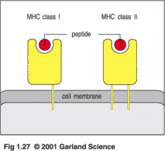Genetic risk for multiple sclerosis tracked to MHC genes
There's long been a debate regarding the effect of genetics versus environment in the development of multiple sclerosis, a debilitating autoimmune disease which strikes young adults (and women, disproportionately). Many of the genetic studies have focused on a group of genes which make up the major histocompatibility complex (MHC). The proteins these genes encode were first discovered as a result of using skin grafts on burned soldiers during World War II. The patients rejected the grafts, and using a mouse model, it was determined that this rejection was due to an immune response. This response was tracked to one region of the genome, later termed the major histocompatibility complex. The main role of these molecules is in antigen recognition by T cells (see figure below).

A current report suggests that indeed, the MHC genes are the only ones which play an essential role in multiple sclerosis.
So, though this information isn't exactly new, it's encouraging to have a definitive area to focus on. Many people have suggested a link between autoimmune disease and certain types of infection, though no definitive agents have been identified to date. Research into other autoimmune diseases may also benefit from these types of linkage analyses.
References:
Janeway C, et al. Immunobiology. The Immune System in Health and Disease. 2001. Garland Publishing: New York, New York. (Image taken from this text).

A current report suggests that indeed, the MHC genes are the only ones which play an essential role in multiple sclerosis.
"Our results confirm the strong role of the major histocompatibility complex genes in MS, and provides a definitive statement that no other region of the genome harbors a gene with a similar overall influence on MS genetics," said Jonathan Haines, Ph.D, of Vanderbilt University in Nashville, Tennessee, who presented on behalf of the International Multiple Sclerosis Genetics Consortium.
So, though this information isn't exactly new, it's encouraging to have a definitive area to focus on. Many people have suggested a link between autoimmune disease and certain types of infection, though no definitive agents have been identified to date. Research into other autoimmune diseases may also benefit from these types of linkage analyses.
References:
Janeway C, et al. Immunobiology. The Immune System in Health and Disease. 2001. Garland Publishing: New York, New York. (Image taken from this text).


